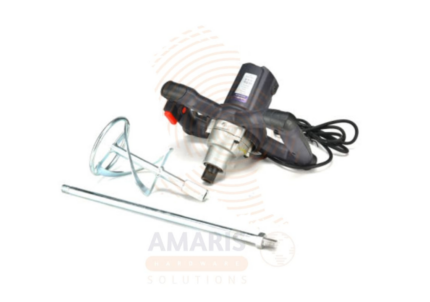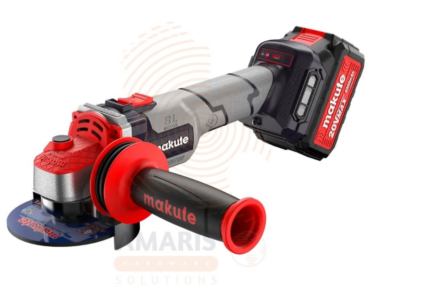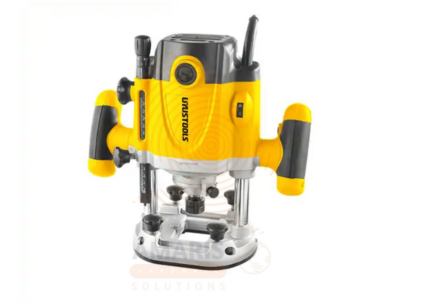Mitre Saw Industrial
$107.69 Original price was: $107.69.$102.31Current price is: $102.31.
A Mitre Saw Industrial, also known as a miter saw, is an industrial cutting tool designed for precision cutting of materials such as wood, metal, or plastic. It features a mounted circular saw blade that can be pivoted horizontally and vertically, allowing users to make accurate angled cuts, or mitre cuts, at various degrees. Mitre saws are commonly used in woodworking, carpentry, and metalworking applications to achieve precise and efficient cutting for tasks such as framing, molding, and trim work. Industrial-grade mitre saws often have powerful motors, sturdy construction, and advanced features to meet the demands of professional and heavy-duty cutting applications in industrial settings.
Table of Contents
ToggleMitre Saw Industrial
Uses
-
Woodworking:
-
Trim and Moulding: Mitre saws are commonly used for cutting trim and moulding pieces with precision, ensuring seamless joints and angles.
-
Framing: Ideal for making accurate angled cuts when framing structures, such as houses or other wooden constructions.
-
Cabinet Making: Mitre saws are valuable in crafting cabinets and furniture, providing precise cuts for components like shelves, panels, and frames.
-
-
Carpentry:
-
Construction: Mitre saws are widely used in construction for tasks like cutting framing lumber, rafters, and beams.
-
Flooring Installation: Useful for cutting precise angles when installing hardwood or laminate flooring.
-
-
Metalworking:
-
Metal Fabrication: Industrial mitre saws equipped with appropriate blades can cut through various metals, making them useful in metal fabrication for items like steel tubing or pipes.
-
Welding Preparation: Mitre saws are employed to prepare metal pieces with accurate cuts before welding.
-
-
Plastic Cutting:
-
Plastic Fabrication: Mitre saws with suitable blades can be utilized to cut plastic materials accurately, making them valuable in applications like plastic fabrication and signage production.
-
-
Renovation and Remodeling:
-
Renovation Work: Mitre saws are commonly used in renovation projects for cutting materials like baseboards, crown moulding, and other trim elements.
-
Remodeling: Useful for precision cutting when altering or updating interior spaces.
-
-
DIY and Home Improvement:
-
Home DIY Projects: Mitre saws are popular among DIY enthusiasts for a wide range of projects, including building shelves, crafting furniture, and making decorative items.
-
-
Cabinet Installation:
-
Kitchen and Bathroom Cabinets: Mitre saws are essential for installing cabinets, ensuring accurate cuts for a professional finish.
-
-
Picture Framing:
-
Art and Photography: Mitre saws are used in framing shops to cut precise angles for picture frames.
-
-
Crosscutting and Beveling:
-
Crosscutting: Mitre saws excel at making straight crosscuts through materials.
-
Beveling: The ability to tilt the blade allows for bevel cuts, enhancing the versatility of the tool.
-
-
Site Work:
-
On-Site Construction: Portable mitre saws are valuable on construction sites for their ability to make accurate cuts, contributing to efficient and precise work.
-
Safety Precautions
-
Read the Manual:
-
Always read and thoroughly understand the manufacturer's instruction manual before operating the mitre saw. Follow all guidelines and safety recommendations provided by the manufacturer.
-
-
Personal Protective Equipment (PPE):
-
Wear appropriate PPE, including safety glasses or goggles to protect your eyes from flying debris, hearing protection to guard against loud noise, and dust masks if cutting materials produce airborne particles.
-
-
Clothing:
-
Avoid wearing loose clothing, jewelry, or anything that could get caught in the moving parts of the saw.
-
-
Secure Workpiece:
-
Ensure that the workpiece is securely clamped or otherwise properly secured to prevent it from moving during the cutting process. Unstable workpieces can lead to inaccurate cuts or kickbacks.
-
-
Blade Guard:
-
Always keep the blade guard in place and properly adjusted. The guard helps protect against accidental contact with the saw blade.
-
-
Fence and Stops:
-
Use the saw's fence and stops to guide the workpiece and maintain accurate cuts. Do not remove or bypass these safety features.
-
-
Positioning:
-
Stand to the side of the saw, not directly in line with the blade, to minimize the risk of injury in case of kickbacks.
-
-
Power Disconnect:
-
Disconnect the power source before changing the blade or performing any maintenance on the saw. This prevents accidental starts and ensures safety during blade replacement.
-
-
Blade Selection:
-
Use the appropriate type and size of the blade for the material you are cutting. Ensure the blade is sharp and in good condition.
-
-
Adjustments:
-
Make all necessary adjustments (angle, height, bevel) with the saw turned off and unplugged. Only make adjustments when the blade has come to a complete stop.
-
-
Start-Up Procedure:
-
Wait for the saw blade to reach full speed before making any cuts. Do not force the blade through the material; let the saw do the work.
-
-
Clear the Work Area:
-
Keep the work area clean and free of clutter. Remove sawdust and debris regularly to maintain a clear view and prevent slips.
-
-
Avoid Reach-ins:
-
Never reach in toward the blade while it is in motion. Wait for the blade to come to a complete stop before retrieving cut pieces or making adjustments.
-
-
Training:
-
Ensure that operators are adequately trained and experienced in using the mitre saw. Inexperienced users should receive proper guidance and supervision.
-
-
Emergency Stop:
-
Familiarize yourself with the location of the emergency stop button and know how to use it in case of an emergency.
-


 Acrylic Sealants
Acrylic Sealants Construction Adhesives
Construction Adhesives Double-Sided Tape
Double-Sided Tape Duct Tape
Duct Tape Electrical Tape
Electrical Tape Epoxy & Resins
Epoxy & Resins Masking Tape
Masking Tape
 Automotive Wrenches & Socket Sets
Automotive Wrenches & Socket Sets Battery Chargers & Jump Starters
Battery Chargers & Jump Starters Car Jacks & Stands
Car Jacks & Stands Car Wash & Detailing Products
Car Wash & Detailing Products Diagnostic Tools
Diagnostic Tools Tire Inflators
Tire Inflators Vehicle Lighting
Vehicle Lighting Oil & Lubricants
Oil & Lubricants
 Adhesives & Sealants
Adhesives & Sealants Bricks & Blocks
Bricks & Blocks Cement & Concrete
Cement & Concrete Drywall & Plaster
Drywall & Plaster Flooring (Tiles, Wood, Laminate)
Flooring (Tiles, Wood, Laminate) Lumber & Plywood
Lumber & Plywood Paints, Primers & Coatings
Paints, Primers & Coatings Insulation Materials
Insulation Materials Roofing Materials
Roofing Materials
 Circuit Breakers
Circuit Breakers Electrical Cables & Wires
Electrical Cables & Wires Switches & Sockets
Switches & Sockets Fuses & Relays
Fuses & Relays Connectors & Terminals
Connectors & Terminals Electrical Boxes & Panels
Electrical Boxes & Panels Conduit & Fittings
Conduit & Fittings Lighting Fixtures & Bulbs
Lighting Fixtures & Bulbs Extension Cords & Power Strips
Extension Cords & Power Strips
 Anchors
Anchors Bolts
Bolts Clips & Clamps
Clips & Clamps Screws
Screws Nuts
Nuts Washers
Washers Rivets
Rivets Nails
Nails Threaded Rods
Threaded Rods
 Hammers
Hammers Measuring Tools (Tapes, Levels, Calipers)
Measuring Tools (Tapes, Levels, Calipers) Screwdrivers
Screwdrivers Pliers & Cutters
Pliers & Cutters Saws & Blades
Saws & Blades Chisels & Punches
Chisels & Punches Allen Keys & Hex Keys
Allen Keys & Hex Keys Ratchets & Socket Sets
Ratchets & Socket Sets Wrenches & Spanners
Wrenches & Spanners
 Power Tool Accessories (Blades, Bits, Discs)
Power Tool Accessories (Blades, Bits, Discs) Rotary Tools
Rotary Tools Saws (Circular, Jigsaw, Reciprocating)
Saws (Circular, Jigsaw, Reciprocating) Drills & Drivers
Drills & Drivers Grinders & Sanders
Grinders & Sanders Heat Guns
Heat Guns Nail Guns
Nail Guns Impact Wrenches
Impact Wrenches Batteries & Chargers
Batteries & Chargers
 Pipes & Fittings (PVC, Copper, PEX)
Pipes & Fittings (PVC, Copper, PEX) Plumbing Tools
Plumbing Tools Pumps & Motors
Pumps & Motors Sealants & Adhesives for Plumbing
Sealants & Adhesives for Plumbing Valves & Taps
Valves & Taps Water Heaters
Water Heaters Drainage Systems
Drainage Systems Faucets & Fixtures
Faucets & Fixtures Hoses & Tubing
Hoses & Tubing
 Hinges & Latches
Hinges & Latches Hooks & Brackets
Hooks & Brackets Window Hardware
Window Hardware Chains & Cables
Chains & Cables Casters & Wheels
Casters & Wheels Shelving & Storage Systems
Shelving & Storage Systems Door Handles & Locks
Door Handles & Locks Drawer Slides & Cabinet Hardware
Drawer Slides & Cabinet Hardware
 Personal Protective Equipment (PPE)
Personal Protective Equipment (PPE) Respirators & Masks
Respirators & Masks Safety Glasses
Safety Glasses Safes
Safes Security Cameras
Security Cameras Gloves
Gloves Helmets
Helmets Ear Protection
Ear Protection Fire Safety Equipment
Fire Safety Equipment Locks & Padlocks
Locks & Padlocks Motion Sensors & Alarms
Motion Sensors & Alarms
 Garden Fencing
Garden Fencing Garden Furniture Hardware
Garden Furniture Hardware Lawn Mowers
Lawn Mowers Trimmers & Edgers
Trimmers & Edgers Shovels & Spades
Shovels & Spades Rakes & Hoes
Rakes & Hoes Pruning Shears & Loppers
Pruning Shears & Loppers Watering Systems (Hoses, Sprinklers, Nozzles)
Watering Systems (Hoses, Sprinklers, Nozzles)
 Interior Paints
Interior Paints Paint Brushes & Rollers
Paint Brushes & Rollers Paint Strippers & Thinners
Paint Strippers & Thinners Paint Trays & Accessories
Paint Trays & Accessories Exterior Paints
Exterior Paints Spray Paints
Spray Paints Primers & Undercoats
Primers & Undercoats Varnishes & Stains
Varnishes & Stains
 Gaskets & Seals
Gaskets & Seals Hydraulic Fittings
Hydraulic Fittings Industrial Fasteners
Industrial Fasteners Industrial Hoses
Industrial Hoses Lubricants & Greases
Lubricants & Greases Metal Sheets & Bars
Metal Sheets & Bars Bearings & Bushings
Bearings & Bushings Belts & Pulleys
Belts & Pulleys
 HVAC Filters
HVAC Filters Insulation for HVAC
Insulation for HVAC Air Conditioners
Air Conditioners Refrigerants
Refrigerants Ventilation Ducts & Fittings
Ventilation Ducts & Fittings Thermostats & Controllers
Thermostats & Controllers Fans & Blowers
Fans & Blowers
 Pegboards & Hooks
Pegboards & Hooks Shelving Units
Shelving Units Storage Bins & Containers
Storage Bins & Containers Toolboxes & Tool Chests
Toolboxes & Tool Chests Workbenches
Workbenches Drawer Organizers
Drawer Organizers Labeling Supplies
Labeling Supplies
 Welding Accessories (Clamps, Brushes)
Welding Accessories (Clamps, Brushes) Welding Electrodes & Rods
Welding Electrodes & Rods Welding Helmets & Gloves
Welding Helmets & Gloves Welding Machines
Welding Machines Soldering Irons & Stations
Soldering Irons & Stations Flux & Solder Wire
Flux & Solder Wire
 Generator Accessories
Generator Accessories Inverters
Inverters Portable Generators
Portable Generators Power Inverters
Power Inverters Transfer Switches
Transfer Switches Diesel & Gasoline Generators
Diesel & Gasoline Generators
 Transport Equipment: Carts, Dollies, and Hand Trucks
Transport Equipment: Carts, Dollies, and Hand Trucks Storage Solutions: Pallets, Racks, and Containers
Storage Solutions: Pallets, Racks, and Containers Lifting Equipment: Hoists, Cranes, and Jacks
Lifting Equipment: Hoists, Cranes, and Jacks Conveyors and Accessories: Belts and Rollers
Conveyors and Accessories: Belts and Rollers







